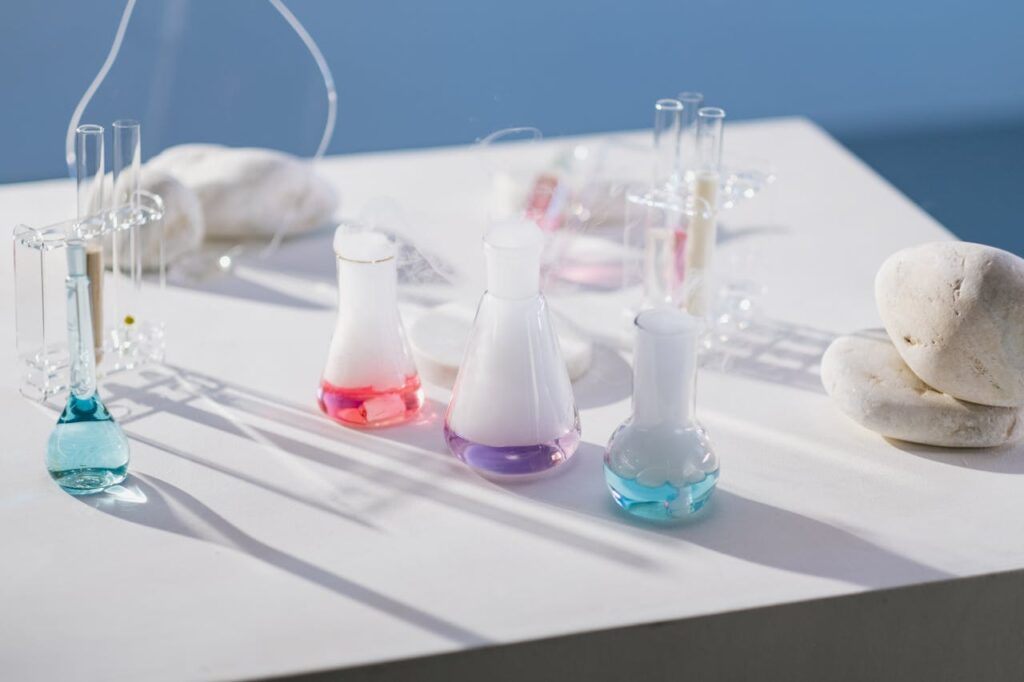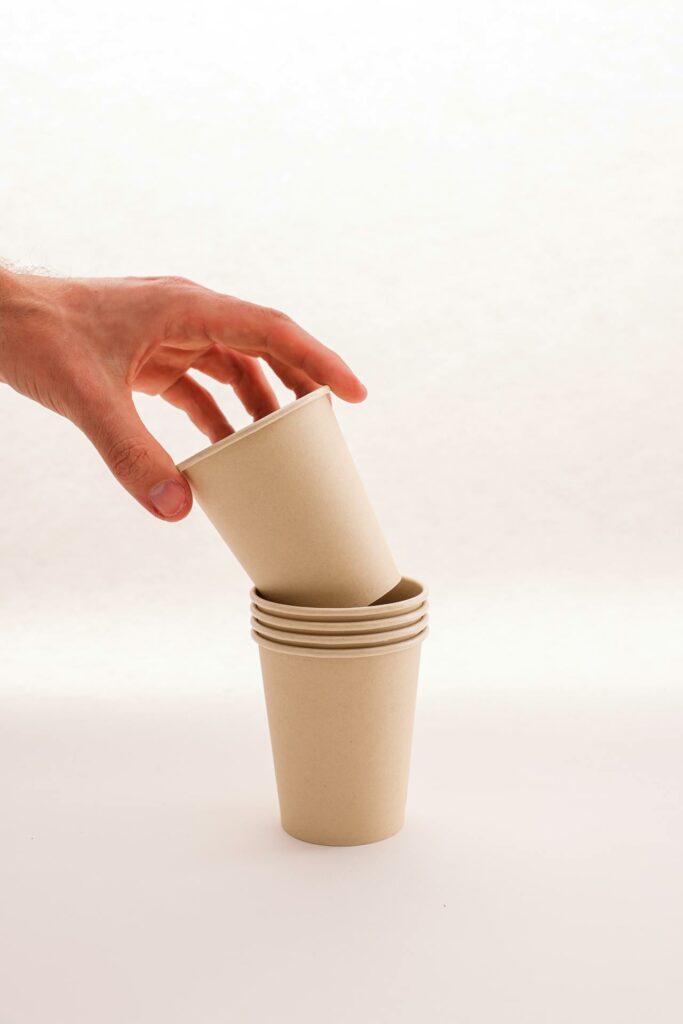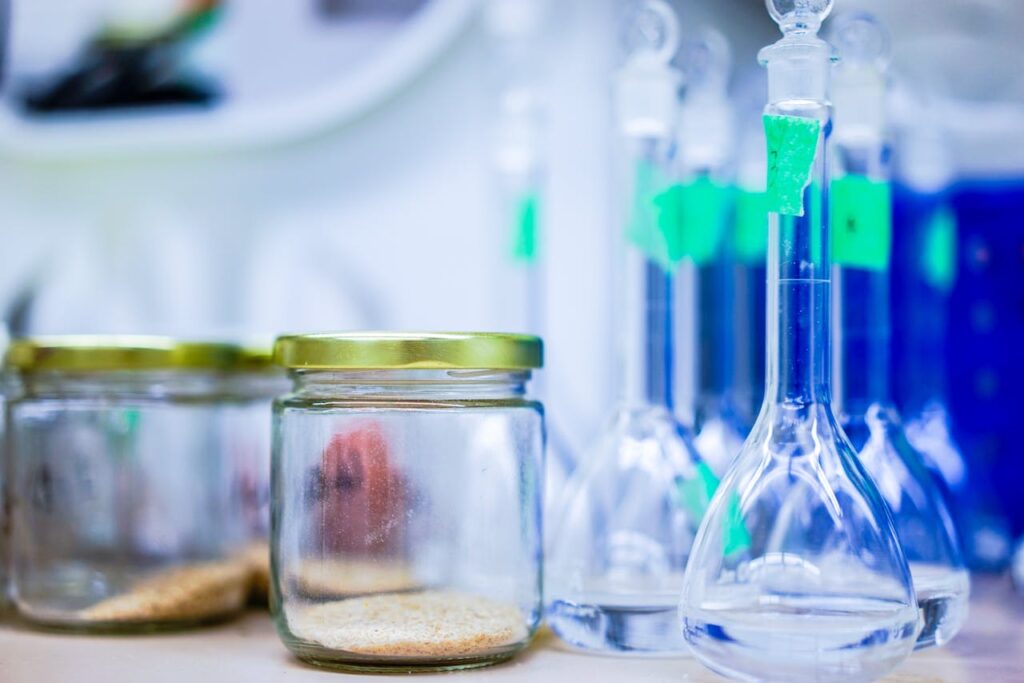Deformulation , or reverse engineering, is an analytical approach that involves analyzing a finished product to identify its components, understand its chemical structure, and understand its functions. Although often underestimated in industrial projects, deformulation analysis is a powerful strategic lever for reformulating a product, monitoring the competition, improving performance, or meeting regulatory requirements. Whether it's a polymer, a cosmetic, an adhesive, or an agri-food product, this approach offers an in-depth view of product composition. This article guides you through its principles, methods, practical applications, and the benefits it brings, illustrated by the field expertise and analytical services offered by YesWeLab.
Table of Contents
What is deformulation?
Definition and general principle
Deformulation analysis involves identifying and quantifying the various components of a product or complex formulation. It aims to trace back to the "original recipe" of a material by analyzing its components, whether organic, mineral, volatile, or polymeric. This approach is based on a rigorous sequence of analytical steps, combining separation, structural identification, and quantification techniques.
Also called reverse engineering , deformulation does not simply consist of detecting the substances present, but of understanding their role in the final formulation : polymer matrix, mineral fillers, plasticizers, solvents, additives, functional agents, etc. It is this global understanding which then allows strategic exploitation of the results.
Reverse engineering for innovation
Unlike a targeted analysis, which aims to detect a specific molecule or group of substances (such as phthalates , PAHs , heavy metals ), deformulation is a global analysis. Its aim is not to verify a criterion, but to map an entire formulation.
This process is particularly useful in the following cases:
- analyze a competing product for a benchmarking or technological monitoring exercise;
- understand the reasons for a performance defect or product failure;
- document regulatory compliance (MSDS, REACH, INCI, etc.) in the absence of supplier data;
- establish specifications or a reference framework for double sourcing of materials.
It is therefore not just a question of knowing the chemical composition of a product, but of understanding its functional architecture: how the different elements interact, in what proportions, and according to what technical logic.
What deformulation is not
Deformulation is neither automatic reproduction nor a counterfeiting method. It does not allow for the identical reconstruction of a secret or patented formula. However, it can highlight relevant or revealing technical choices, inspire reformulation, or identify nonconformities.
Finally, it does not oppose reformulation: it is often the first step. Once the technical data has been extracted from an existing product, it becomes possible to:
- reconstruct an equivalent formulation (me-too product);
- improve an existing formula (optimization, substitution);
- adapt a product to new specifications.
Thus, deformulation is essential as a scientific decision-making tool for R&D, quality or regulatory teams.

Why perform deformulation?
Deformulation is not a purely academic approach. It meets concrete and frequent needs in industrial environments where detailed knowledge of a product's composition can influence strategic decisions. Whether for regulatory, technical, or commercial reasons, deformulation constitutes a powerful analysis tool for R&D, quality, or purchasing departments.
Identify an unknown raw material or product
One of the most common uses of deformulation is the identification of an unknown material. This situation arises, for example, when a manufacturer wants to know the precise composition of a competing material or a sample without technical documentation. Through in-depth analysis, the laboratory can determine:
- the nature of the polymer (PE, PP, PU, PLA, etc.);
- incorporated additives (plasticizers, stabilizers, anti-UV agents);
- the fillers or pigments present.
This type of analysis makes it possible to build a technical sheet from a simple sample, thus facilitating alternative sourcing, reformulation or responding to a customer need.
Compare two similar products
When double-sourcing or changing suppliers, it is often necessary to verify that two products, although presented as equivalent, are actually equivalent from a physicochemical point of view. Deformulation allows two formulations to be compared in depth:
- verification of batch homogeneity;
- control of filler or additive rates;
- highlighting undeclared differences between samples.
These comparisons are crucial to ensure the stability of industrial processes and the reproducibility of product performance.
Understanding a defect or degradation
Another frequent application is the analysis of an unexpected defect on a finished product: loss of adhesion, change of color, fragility, blistering, etc. In this case, deformulation makes it possible to identify:
- an impurity or contaminant (exogenous or process-related);
- a variation in composition between a conforming batch and a non-conforming batch;
- an additive degraded by temperature or aging.
This type of comparative study makes it possible to get to the root cause of a defect and to propose rapid and well-founded corrective action.
Meet regulatory requirements
Certain regulations require exact knowledge of the composition of a product, particularly in the sectors:
- medical devices (REACH compliance, biocompatibility);
- food packaging (EC Regulation No. 1935/2004);
- cosmetics (INCI compliance, absence of prohibited substances);
- of the environment (analysis of hazardous substances, assessment of recyclability).
Deformulation then becomes an essential step to complete a technical file, demonstrate compliance with a standard or establish a reliable regulatory declaration.
Substitute a material or adapt a formulation
Faced with shortages, rising costs of certain raw materials, or regulatory bans, manufacturers are sometimes forced to modify their formulations. In this context, deformulation allows:
- to identify the key components of a reference product;
- to understand the function of each ingredient;
- to reconstruct an alternative formulation with functional equivalents.
This approach is particularly useful in the context of a transition towards bio-sourced, recycled or less harmful materials for human health and the environment.
Protect or defend intellectual property
Deformulation can also be used in a legal or competitive context. It allows, for example:
- to check whether a competing product contains elements protected by a patent;
- to demonstrate a potential infringement of intellectual property (IP);
- to document an action for unfair competition.
In this context, laboratories must follow rigorous protocols, with complete traceability and enforceable results.
Deformulation is therefore not just a diagnostic tool: it becomes a strategic lever for securing, improving, or promoting industrial activity. It supports both corrective actions and innovation approaches.
Are you looking for an analysis?

What are the steps of deformulation?
The success of a deformulation project relies on a rigorous and structured methodology. Each step is designed to meet a specific objective: collecting initial information, guiding analyses, separating components, and then accurately identifying them. This step-by-step approach allows the techniques to be adapted to the specific characteristics of the sample being analyzed, while ensuring the reliability of the results.
Step 1: Collection of documentary data
Before any instrumental analysis, an initial documentation phase is essential. It aims to gather as much information as possible about the product to be analyzed, whether known or completely unknown. This collection includes:
- technical data sheets and safety data sheets (SDS);
- any associated patents;
- supplier data or INCI sheets in the case of cosmetics;
- information about the manufacturing process or product history.
This step helps to frame the study, guide the initial hypotheses and define the analysis objectives. It is crucial to avoid unnecessary or inappropriate analyses.
Step 2: Global and preliminary analyses
Once the initial information has been collected, comprehensive analyses are conducted to better understand the material's behavior. These non-specific tests help guide future methodological choices. They may include:
- the study of density or granulometry to characterize the physical appearance of the material;
- solubility in different solvents to guide extractions ;
- preliminary spectroscopic analyses such as IRTF or UV-Visible;
- thermal tests (ATG, DSC) to determine transition or degradation temperatures.
These tests provide an initial insight into the complexity of the mixture and allow targeting of the specific analysis techniques best suited to the sample.
Step 3: Separation of components
The central step in deformulation consists of separating the different families of components . For this, several techniques are used, depending on the nature of the product:
- selective extractions using suitable solvents (organic or aqueous);
- filtration or centrifugation to isolate solid or liquid phases;
- preparative chromatography to recover isolated fractions of compounds;
- targeted chemical reactions (e.g., selective precipitation, controlled hydrolysis) to dissociate bound ingredients.
The difficulty often lies in the complex nature of the matrix: crosslinked polymers, emulsions, mixtures of volatile and non-volatile ingredients, etc. This is why this step requires advanced technical expertise and a good knowledge of the target formulation.
Step 4: Identification and quantification of constituents
Once the components have been separated, the laboratory proceeds to their precise identification using advanced analytical techniques. Depending on the case, several methods can be combined:
- liquid chromatography (HPLC) or gas chromatography (GC-MS) for organic molecules;
- high-resolution mass spectrometry (LC-QTOF/MS) for additive screening;
- infrared spectroscopy (IRTF) for functional groups;
- scanning electron microscopy (SEM-EDX) for inorganic fillers;
- size exclusion chromatography (GPC) for molar mass distribution.
This step not only allows the substances present to be identified, but also their relative or absolute concentration in the finished product to be assessed.
Step 5: Interpretation and synthesis of results
The analysis does not stop at producing raw results. It continues with a cross-interpretation of the data :
- consistency between the different techniques used;
- highlighting synergies or incompatibilities between components;
- comparison with a reference product (as part of a benchmark or non-conformity);
- recommendations for reformulation or corrective action.
The deformulation report must provide a clear and usable vision of the composition of the product analyzed, with vocabulary adapted to the technical level of the client (formulator, buyer, quality engineer, etc.).
These five steps, although presented in a linear manner, are in reality often iterative: the results of an analysis can lead to relaunching a complementary extraction or testing an unexpected hypothesis. It is this adaptability that makes the strength of a laboratory experienced in deformulation.

What are the analytical methods used for deformulation?
Deformulation relies on a combination of complementary analytical techniques. No single method can fully decode the composition of a complex product. It is the synergy between the different approaches that makes the analysis reliable and comprehensive. These methods identify the chemical nature of the components, their structure, their particle size distribution, and even their thermal behavior. Here is a detailed overview of the main techniques used in the laboratory.
Spectroscopic techniques
transform infrared spectroscopy (FTIR)
FTIR is an essential basic method for identifying functional groups present in a formulation. It allows, by comparison with spectral databases, to obtain a chemical signature of the analyzed materials. It is particularly useful for:
- determine the nature of the main polymer (PE, PU, PLA, etc.);
- detect additives such as antioxidants, plasticizers or anti-UV agents;
- check the presence of components characteristic of a formulation (e.g. ester groups, amides, aromatics, etc.).
Nuclear magnetic resonance (NMR)
NMR (proton or carbon) is a more detailed technique used to determine the molecular structure of organic compounds. It can identify the exact sequence of a polymer or precursor, or confirm the presence of a compound based on its specific spectrum. It is generally used in the final phase of deformulation, to validate a hypothesis formulated from more global analyses.
Chromatographic techniques
Gas chromatography ( GC-MS / GC)
GC-MS allows the analysis of volatile and semi-volatile molecules present in a formulation:
- residual solvents;
- light plasticizers;
- unreacted monomers;
- texturizing agents or fragrances.
Headspace mode is particularly useful for liquid or pasty samples, as it allows volatile compounds to be analyzed without prior extraction.
High-performance liquid chromatography (HPLC)
HPLC allows the separation and measurement of non-volatile substances , often present in low concentrations, such as:
- antioxidants;
- water-soluble dyes;
- active substances in cosmetics or medical devices.
Coupled with mass spectrometry detection (LC-QTOF/MS), it becomes a very powerful tool for screening several hundred additives.
Size exclusion chromatography (GPC/SEC)
GPC (Gel Permeation Chromatography) is a technique for separating molecules based on their size. It is widely used to analyze the molar mass distributions of polymers, an essential parameter for:
- determine the degree of polymerization;
- compare resins from different suppliers;
- assess the impact of aging on the structure of the material.
Thermal techniques
Thermogravimetric analysis (TGA)
TGA measures the mass loss of a sample as a function of temperature. It can identify:
- degradation temperatures;
- volatile fractions (solvents, additives);
- mineral residues, often associated with inorganic fillers (TiO₂, CaCO₃, etc.).
For an accurate interpretation, you can refer to our D10 D50 D90 particle size analysis , which describes the characteristic size indices.
Differential scanning calorimetry (DSC)
DSC measures the thermal transitions of a material, such as:
- the melting temperature;
- the crystallization temperature;
- the glass transition (Tg).
This information is valuable for qualifying a polymer, identifying a type of resin or comparing two similar formulations.
Dynamic Mechanical Analysis (DMA)
DMA complements DSC by analyzing the viscoelastic behavior of a material subjected to mechanical stress varying in temperature. It is useful for understanding the mechanical resistance of a polymer in its real environment of use. Combined with rheological analysis , deformulation allows for a better understanding of the mechanical and textural properties of formulations.
Microscopy and elemental analysis techniques
Scanning electron microscopy (SEM) coupled with EDX
SEM-EDX allows the surface structure of a material to be visualized with very high resolution, and the elemental composition . This method is often used for:
- identify inorganic fillers;
- visualize defects or inclusions in a polymer matrix;
- compare the distribution of pigments or reinforcing fibers.
Optical microscopy and laser granulometry
Optical microscopy allows direct observation of samples, useful for identifying the macroscopic phases of a mixture. Laser granulometry, on the other hand, provides a precise measurement of the particle size distribution , essential in powders or emulsions.
Other techniques such as sedimentation dynamics analysis can also be used to characterize complex suspensions or emulsions. Grain size measurement also allows for detailed characterization of powdered or bulk materials.

What types of products can be deformulated?
Deformulation applies to a wide variety of products from a variety of industrial sectors. From technical adhesives to high-performance polymers, printing inks, and food packaging, many complex materials can be analytically deconstructed to understand their formulation. What these products have in common is that they are all made up of mixtures of organic and/or mineral components, often dispersed, bound, or encapsulated in a matrix.
Polymers and plastic materials
Polymers are among the most frequently deformulated products. They are ubiquitous in industry and come in a wide variety of formulations. Deformulated plastic materials can be:
- thermoplastics polyethylene PE, polypropylene PP, polystyrene PS, PVC, etc.);
- elastomers (EPDM, silicone, natural or synthetic rubber) ;
- technical polymers or reinforced composites (PA, POM, PBT, PC, etc.);
- bio-sourced or biodegradable polymers ( PLA, PBS).
These materials may contain various additives (flame retardants, UV stabilizers, antioxidants, pigments, plasticizers) as well as fillers (talc, silica, fiberglass). Deformulation makes it possible to identify all these elements and assess their relative proportion.
Inks, paints and varnishes
Liquid or semi-liquid formulations such as printing inks , industrial paints , technical varnishes or functional coatings are also common candidates for deformulation. These products often contain:
- a polymer resin (main binder);
- pigments (organic or inorganic);
- solvents (ethanol, acetate, toluene, etc.);
- rheology agents, catalysts, plasticizers or polymerization retarders.
The objective of deformulation may be to compare two competing formulations, to identify a source of incompatibility with a support, or to understand a loss of performance (e.g. poor outdoor performance, premature aging).
Adhesives and glues
Industrial glues and adhesives are complex systems, often designed to operate under demanding conditions (humidity, temperature, UV, etc.). There are several main families:
- melt adhesives based on resins;
- solution adhesives containing organic solvents;
- emulsion (water-based) adhesives
- two -component adhesives (epoxy, polyurethane, methacrylate, etc.).
Deformulation can help identify the polymer base, fillers, tackifying resins, solvents and catalysts, or detect the presence of impurities responsible for non-conformity.
Cosmetics and care products
Cosmetic products often contain a very complex matrix combining aqueous and oily phases, active ingredients, texturizing agents, perfumes, preservatives, UV filters, etc. Deformulation applies to products such as:
- creams, lotions, gels and body milks;
- lipsticks, foundations, mascaras;
- shampoos, conditioners, soaps and hair products.
The challenge may be to monitor regulatory compliance (cosmetic regulation EC 1223/2009), to reformulate a product without a controversial ingredient, or to identify an allergen or contaminant.
Food packaging products
Packaging, especially packaging in direct contact with food, is subject to strict regulations (EC Regulation No. 1935/2004, FDA standards). Materials covered include:
- multi-layer plastic films ( barrier, heat-sealable, biodegradable);
- surface inks and varnishes ;
- assembly glues for labels or complex structures;
- recycled plastics .
Deformulation allows:
- check for the absence of prohibited or undeclared substances;
- control the actual composition of a recycled material;
- assess the compatibility of a material with a given foodstuff.
Other deformulated products
Many other products can be deformulated, including:
- formulations or medical devices ;
- technical industrial products ( degreasers, lubricants, process fluids);
- photopolymerizable formulations ( UV inks, EB varnishes);
- construction materials ( insulating foams, coatings, technical glues).
In any case, the feasibility of a deformulation project depends on the complexity of the matrix, the quantity of sample available, and the purpose of the analysis. Thanks to a multi-technical approach and in-depth expertise in materials chemistry, specialized laboratories can meet a wide variety of industrial demands.

Which industrial sectors are affected?
Deformulation concerns a very wide range of sectors, as it meets universal needs: understanding a product's composition, ensuring its compliance, improving its performance, or meeting a regulatory requirement. From food to cosmetics, including plastics, animal health, and packaging, many industries rely on specialized laboratories to deformulate their products. Here's an overview of the main sectors concerned and the specific challenges for each.
Agri-food: traceability, safety and innovation
In the food industry, deformulation can concern:
- food contact packaging ( plastic films, inks, glues);
- additives or flavorings integrated into complex formulations;
- processed products with uncertain composition (sauces, food supplements, powders, etc.).
The objectives can be:
- verify compliance with European regulations (INCO, CE 1935/2004);
- identify an unwanted component or contaminant;
- analyze the competition or develop an alternative recipe.
The techniques used (GC-MS, HPLC, ATG, IRTF, etc.) allow the detection of both major components and traces, with a high level of precision.
Our agri-food analysis laboratories support manufacturers on issues of safety, traceability and compliance of materials in contact with food.
Cosmetics: transparency, regulation and reformulation
The cosmetics sector is particularly demanding of deformulation, notably in a context of:
- substitution of controversial substances (parabens, silicones, allergens);
- regulatory validation (INCI compliance, contaminant analysis);
- competitive intelligence (study of branded products or reformulation).
The products targeted range from creams to perfumes, including shampoos, foundations and varnishes. The complexity of the matrices (emulsions, suspensions, oil-water mixtures) requires a combination of techniques: LC-QTOF, NMR, GC Headspace, microscopy, etc.
Animal and veterinary health: safety and performance
In the veterinary field, deformulation is used for:
- analyze nutritional products or supplements for animals ;
- understand a therapeutic failure or an unexpected reaction;
- check compliance with supplier specifications.
Formulations based on vitamins, plant extracts, minerals, or organic acids are studied to ensure their safety and efficacy. HPLC and mass spectrometry are key tools for the measurement of active ingredients.
Materials, plastics and polymers: quality and competitiveness
Plastics processing has historically been one of the sectors most affected by deformulation. The objectives are multiple:
- analyze a new polymer or recycled material ;
- identify the components of a competing product ;
- understand a non-conformity or a defect on a part (fragility, cracking, loss of color, etc.).
The sectors concerned are numerous: automotive, aeronautics, construction, sports, electronics. The combination of ATG, GPC, SEM-EDX, DSC and IR allows for complete characterization of materials.
Medical devices and human health: compliance and safety
Deformulation is essential for medical devices and health products (gels, implants, contact materials, surgical adhesives, etc.). These products must:
- comply with ISO 10993 standards (biocompatibility);
- be free from substances prohibited under REACH or the annexes of the cosmetic regulation;
- ensure flawless stability and performance.
The laboratories analyze both materials (polymers, silicones, adhesives) and active formulations (antimicrobial agents, excipients, active ingredients).
Environment and recycling: traceability of flows and control of materials
In a context of ecological transition, deformulation is becoming increasingly important for:
- control the actual composition of recycled materials (plastics, composites, metals, etc.);
- identify the presence of substances of concern (brominated flame retardants, phthalates, PAHs);
- document the recyclability of a product at the end of its life.
The analyses also make it possible to qualify the inputs into a reuse or upcycling sector, with a high level of traceability.
Packaging: food safety and sustainable innovation
The packaging sector, and in particular materials in contact with foodstuffs , uses deformulation to:
- ensure compliance (EC Regulation No. 1935/2004) and American (FDA) standards
- check for the absence of migration of undesirable substances (inks, solvents, glues);
- improve the barrier or mechanical performance of packaging.
This applies to rigid plastics as well as complex films, inks, adhesives or internal coatings.

How much does deformulation cost?
The cost of deformulation can vary considerably depending on the nature of the product being analyzed, the complexity of its formulation, the objectives of the study, and the analytical methods used. This is not a standardized service: each project is unique and requires a tailored approach. This section details the main factors that influence the price of a deformulation service, as well as the price ranges commonly encountered in the sector.
Parameters that influence the price
The complexity of the matrix to be analyzed
The more complex a product is in terms of the number of components, the diversity of chemical families, or its molecular architecture, the longer and more expensive the analyses will be. A simple single-component plastic will cost less to deformulate than a multi-layer UV varnish or a cosmetic cream containing aqueous and oily phases, active ingredients, preservatives, and fragrances.
The expected level of detail
Deformulation can be carried out at different levels:
- exploratory analysis : semi-quantitative approach, allowing the identification of the main families of components;
- comprehensive and quantitative analysis : precise identification of all constituents with quantification and cross-validation;
- comparative analysis : two or more samples to be compared according to an identical protocol.
The more in-depth the study, the higher the cost. The precision required (absolute quantification, trace search, pollutant detection, etc.) determines the instruments to be used and the analysis time.
The volume and condition of the samples
An insufficient volume or a sample that is too small can make certain analyses more difficult (or impossible), which requires the use of more sensitive and more expensive methods. Conversely, a sample that is too heterogeneous or poorly conditioned (polluted, unstable, composite, etc.) will require additional preparation steps.
The analytical techniques used
Some techniques are more expensive to implement than others:
- pyrolysis -GCMS , LC-QTOF/MS or NMR are sophisticated and expensive methods;
- simpler techniques such as IRTF , TGA or laser granulometry are more economical.
The final cost will therefore depend on the number and type of techniques needed to achieve the set objectives.
The requested completion time
A standard deformulation project (2 to 4 weeks) is generally less expensive than an emergency analysis. Some laboratories offer express services, but apply a significant surcharge due to the rapid mobilization of equipment and human resources.
Price range observed on the market
Although each project is subject to a personalized quote, we can estimate the following average costs (excluding taxes, for information purposes only):
- simple deformulation (standard polymer, 2 to 3 analytical methods): between 800 and 1500 euros ;
- intermediate deformulation (multi-component product, comparative approach): between 2000 and 3500 euros ;
- complex deformulation (cosmetics, glue, medical device, sensitive formulation): between 4000 and 8000 euros ;
- expert project (extended LC-MS screening, complete quantification, integrated reformulation): over 10,000 euros .
These amounts generally include:
- sample handling;
- physicochemical analyses;
- interpretation of results;
- a complete and annotated report.
reformulation services , regulatory advice , or additional tests (accelerated aging, migration, stability, etc.).
Why it is essential to request a personalized quote
Every deformulation project begins with a discussion with the laboratory or analytical service provider. It is essential to:
- clearly define the objective of the analysis;
- provide precise technical information on the sample (shape, mass, history, usage environment, etc.);
- indicate the level of detail expected, time constraints and, where applicable, the regulatory context.
A personalized quote helps avoid any unpleasant surprises and optimizes the cost/relevance ratio of the study. Many of YesWeLab's partner laboratories offer a free initial feasibility analysis , allowing the technical interest of a project to be validated before making a financial commitment.
Deformulation is a strategic investment which, although sometimes costly, can generate a rapid return on investment when it is well targeted: better knowledge of materials, dispute resolution, securing supply, innovation or access to new markets.

Why use YesWeLab for your deformulation projects?
Deformulation is a demanding technical process that requires a thorough understanding of analytical methods, expert interpretation of results, and the ability to transform this data into operational decisions. To ensure the success of your projects, working with YesWeLab provides you with comprehensive scientific support, rapid access to a large network of specialized laboratories, and centralized management via a digital platform. Here are the benefits of choosing YesWeLab for your deformulation analyses in detail.
Privileged access to a network of 200 laboratories
YesWeLab brings together a network of more than 200 analysis laboratories in France and Europe, specializing in complementary fields:
- analysis of polymers and plastic materials;
- characterization of cosmetic or pharmaceutical products;
- detection of chemical contaminants in food or packaging;
- migration , aging, stability tests, etc.
This network makes it possible to quickly mobilize the best analytical skills for each type of project, depending on the nature of the product, the objective of the study, and regulatory requirements.
A digital platform to centralize your analyses
Thanks to its all-in-one digital platform , YesWeLab simplifies the management of your analytical projects. This intuitive interface allows you to:
- easily search and order your services (more than 10,000 analyses available);
- centralize the sending and tracking of your samples;
- monitor the progress of analyses in real time;
- retrieve your reports and certificates of analysis securely.
This approach guarantees considerable time savings , better document traceability , and smooth communication between your teams and partner laboratories.
Recognized multi-sector expertise
YesWeLab supports clients from many industrial sectors:
- agri-food;
- cosmetics;
- animal health;
- environment ;
- packaging and polymer materials;
- food supplements and nutraceuticals.
This diversity allows YesWeLab to offer relevant technical solutions, adapted to the specificities of each sector. Whether reformulating a plastic food film, identifying a defect in a technical glue, or detecting an allergen in a cream, the technical teams know how to mobilize the right analytical tools.
Analyses in accordance with the strictest standards
All YesWeLab partner laboratories carry out their analyses in compliance with international quality standards:
- ISO 17025 : general requirement for the competence of testing laboratories;
- compliance with regulations specific to each sector (EC regulation 1935/2004, INCO, REACH, cosmetic regulations, FDA standards, etc.).
This rigor guarantees the reliability of the results and their regulatory validity , whether for internal use, marketing or certification.
Tailor-made support, from analysis to action
The YesWeLab team doesn't just deliver results. It offers personalized support every step of the way:
- framing of the analytical need;
- choice of the most relevant methods;
A trusted partner for your R&D projects
YesWeLab fits perfectly into your research and development processes by providing you with:
- responsiveness in processing your projects;
- confidentiality of technical data;
- flexibility in managing complex projects;
- reduced lead times through intelligent outsourcing of analyses.
This positioning as an interface between manufacturers and laboratories makes it possible to streamline exchanges, make technical data more reliable and speed up decision-making.




